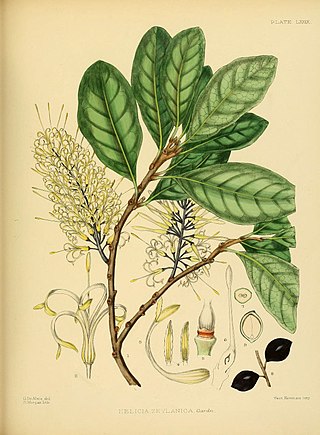
Helicia is a genus of 110 species of trees and shrubs, constituting part of the plant family Proteaceae. They grow naturally in rainforests throughout tropical South and Southeast Asia, including India, Sri Lanka, Indochina, Peninsular Malaysia to New Guinea and as far south as New South Wales.
Heliciopsis is a genus of about thirteen species of trees, constituting part of the flowering plant family Proteaceae. They grow naturally in Burma, Indo-China, SE. China, Thailand, Peninsular Malaysia, Borneo, Sumatra, Java (Indonesia) and the Philippines. The name means similar to the plant genus Helicia. Its closest relatives are Athertonia (Australia) and Virotia.
Helicia attenuata is a plant in the family Proteaceae. The specific epithet attenuata means "drawn out", referring to the leaf base.
Helicia excelsa is a plant in the family Proteaceae. It grows as a tree up to 20 metres (70 ft) tall, with a trunk diameter of up to 25 centimetres (10 in). The bark is dark grey to blackish. Inflorescences bear up to three reddish brown flowers. Fruit is black, ellipsoid, up to 3 centimetres (1 in) long. The specific epithet excelsa is from the Latin meaning "lofty", referring to the tree's growth. Habitat is forests from sea level to 1,700 metres (5,600 ft) altitude. H. excelsa is found in Bangladesh, Burma, Thailand, Malaysia and Indonesia.
Helicia fuscotomentosa is a plant in the family Proteaceae. It grows as a tree up to 25 metres (80 ft) tall, with a trunk diameter of up to 30 centimetres (12 in). The bark is mottled grey and black. The flowers are reddish brown. Its habitat is forests from sea level to 2,000 metres (6,600 ft) altitude. H. fuscotomentosa is endemic to Borneo.
Helicia maxwelliana is a plant in the family Proteaceae. It grows as a treelet up to 3 metres (10 ft) tall. The twigs are dark brown. The flowers are reddish brown. The fruit is black, round, up to 2.5 centimetres (1 in) in diameter. Its habitat is montane forest at 1,600 metres (5,200 ft) to 1,700 metres (5,600 ft) altitude. H. maxwelliana is endemic to Borneo.
Helicia petiolaris is a plant in the family Proteaceae. The specific epithet petiolaris means "stalked", referring to the leaves.
Helicia pterygota is a plant in the family Proteaceae. The specific epithet pterygota means "winged", referring to the pedicel.
Madhuca multinervia is a tree in the family Sapotaceae, native to Borneo. The specific epithet multinervia means "many-veined", referring to the leaves.
Diospyros lanceifolia is a tree in the family Ebenaceae. The specific epithet lanceifolia means "lance-shaped leaves".

Pterophylla fraxinea, formerly known as Weinmannia fraxinea, is a tree in the family Cunoniaceae. It grows up to 40 metres (130 ft) tall. The bark is grey to dark brown. Inflorescences bear up to three pairs of flowers. The specific epithet fraxinea is from the Latin meaning "ash tree", referring to the leaves' resemblance to those of the genus Fraxinus.
Aglaia sessilifolia is a tree in the family Meliaceae. It grows up to 12 metres (40 ft) tall with a trunk diameter of up to 20 centimetres (8 in). The bark is greyish brown or dark brown. The flowers are yellow. The fruits are ellipsoid, up to 2.5 cm (1 in) long. The specific epithet sessilifolia is from the Latin meaning "stalkless leaf". Habitat is limestone hill forests from sea level to 1,000 metres (3,300 ft) altitude. A. sessilifolia is endemic to Borneo and confined to Malaysia's Sabah state.
Buchanania sessilifolia is a tree in the family Anacardiaceae. The specific epithet sessilifolia is from the Latin meaning "leaf without stalk", referring to the sessile leaves.
Vatica borneensis is a tree in the family Dipterocarpaceae, native to Borneo.
Hopea tenuinervula is a tree in the family Dipterocarpaceae, native to Borneo. The specific epithet tenuinervula means "slender nerve", referring to the leaf veins.
Shorea pinanga is a tree in the family Dipterocarpaceae, native to Borneo. The specific epithet pinanga is derived from a local name for the species.
Symplocos colombonensis is a plant in the family Symplocaceae, native to Borneo. It is named for the Colombon River in Sabah.
Symplocos goodeniacea is a tree in the family Symplocaceae, native to Borneo. It is named for the leaves' resemblance to those of species in the family Goodeniaceae.
Helicia symplocoides is a tree in the family Proteaceae, native to Borneo. The specific epithet symplocoides refers to the leaves' resemblance to those of the genus Symplocos.
Helicia rufescens is a tree in the family Proteaceae, native to Southeast Asia. The specific epithet rufescens means "becoming reddish", referring to the indumentum of the inflorescences, twigs and leaves.

